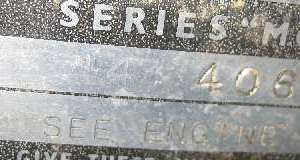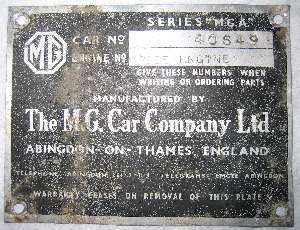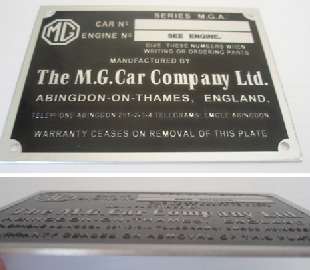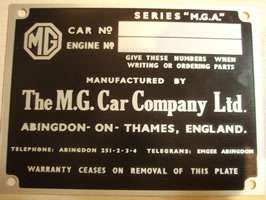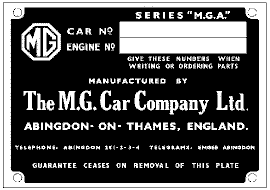The MGA With An Attitude
CAR NUMBER PLATE Original Details -- RT-107
I have so far identified at least five different combinations of engraving, stamping and printing techniques for identifying numbers on the Car No. identity plates for MGA cars. These first two pictures are earliest (known) style representing a range from the 125th production car [June 1955] to mid 1500 production [August 1957]. Early 1500 cars had the engine number stamped on the plate. Later 1500 cars had "SEE ENGINE" stamped on the plate in place of the engine number. For 1600 and MK-II cars the Engine No. said "SEE ENGINE" and was printed on the plate as part of the original black background.
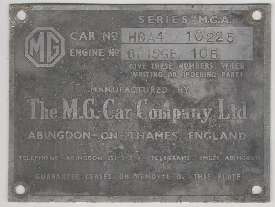
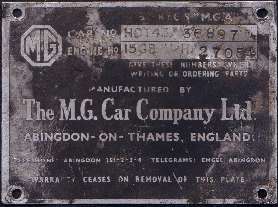
On all number plates the lettering for "The M.G. Car Company Ltd." was very slightly raised from the background, as was the perimeter border and all other background lettering. This was chemically etched, causing the black background at the same time, as the plate is otherwise perfectly flat on the back. The black patina can rub off with time. Notice on this plate the raised lettering is still clearly legible even where some of the black background has been removed. Reproduction plates will most often be black chemical photo print on steel plate or clear and black anodized aluminum, but in most cases perfectly flat with no raised lettering.
For the original numbers on the early plate, the part of the Car No or Engine No which came before the serial number digits appears to have been engraved (cut with a small milling cutter). The numeric chassis number appears to have been stamped without distorting the back of the plate, probably done on a machine prior to attachment to the car. The engine number appears was stamped with considerable distortion of the plate, as it was hand stamped after being attached to the car. This will leave an impression in the heater shelf, but maybe not in the frame goal post, as there was cork packing in between.
Addendum October 28, 2018:
In mid 1957 the factory stopped stamping the engine number on the Car No plate (which was done on the car) and began pre-stamping "SEE ENGINE" in the same space. Trying to narrow down the exact point in production when this changed, here are two Car No places that span the interval.

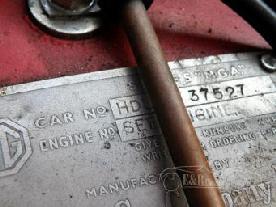
At 10:58 PM 3/11/2008 -0600, Chris Ramirez in Austin, Texas, wrote:
"I have car HDL43 40649 [October 1957]. My plate is as follows: the "HDL43" portion of the car number is so faint, I can barely make out the letters. I missed them at first, but in the right light you can see the top half of the H, the entire L and D, and the top half of the 3. This is definitely not stamped. The rest of the car number is heavily stamped, distorting the plate. The engine number has "SEE ENGINE" lightly stamped, since the plate isn't deformed around this area, using the same font as your 2nd pic's 'see engine'."
The "HDL43" part of the Car No. appears to be chemically etched here, like it was perhaps rubber stamped with the etching chemical. That would be quicker than engraving, possibly done as a cost reduction technique. It would be okay if it worked well, but this often leaves such a poor impression as to be difficult to read. It would be interesting to see how long this lasted in production, if we can find more examples, or closer chassis numbers on either side of it. (If this is engraved it would be extremely shallow penetration of the surface).
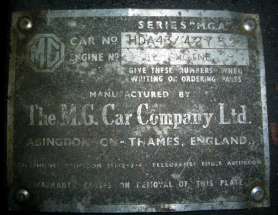
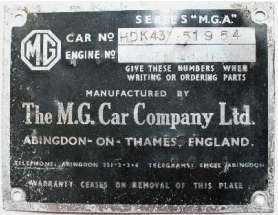
Here are two 1500 plates, the first just a couple thousand cars later (November 1957). These have the Car No. prefix letters machine stamped, all nicely aligned, while the chassis number is hand stamped (variously misaligned numerals). This defines a known range of cars with this style.
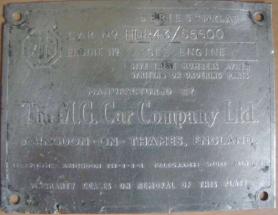
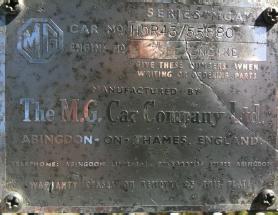
These are images of later 1500 Car No. plates (Aug-Sept 1958). Here the entire Car No. appears to have been machine stamped, all lettering being straight up with constant spacing but slightly misaligned vertically. For Engine No. the words "SEE ENGINE" are stamped in the plate, but with different size font. This was probably done on a different machine in mass production.
I would like to narrow the time reference for the day when these format changes were implemented. If you have an original number plate that falls outside of the ranges shown here, please contact me.
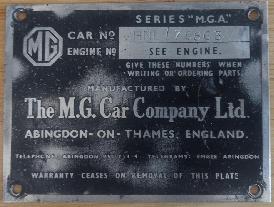 This is a 1600 Car No. plate (September 1959). The "GHNL/" is lightly stamped with slight marking visible on the back side of the plate. All characters are nicely aligned, apparently done by batch processing with an automatic stamping machine. The chassis number "75563" is stamped with different font and slightly heavier impression. The characters have slightly variable slant and are somewhat misaligned vertically, giving the appearance of having been hand stamped. There is a bit more noticeable marking on the back side of the plate, but seems to have been done against a hard surface, so probably done before installation in the car. The Engine No. is "printed" with slight depression, apparently produced as part of the black background, saying "SEE ENGINE." (including the period). This would have required a change of the artwork used for the chemical etching of the basic plate blank. Otherwise the basic plate blank design and production method seems to be unchanged throughout production. Again, if you find a plate like this with lower chassis number, I would like a picture to reduce the number spread for the chang date.
This is a 1600 Car No. plate (September 1959). The "GHNL/" is lightly stamped with slight marking visible on the back side of the plate. All characters are nicely aligned, apparently done by batch processing with an automatic stamping machine. The chassis number "75563" is stamped with different font and slightly heavier impression. The characters have slightly variable slant and are somewhat misaligned vertically, giving the appearance of having been hand stamped. There is a bit more noticeable marking on the back side of the plate, but seems to have been done against a hard surface, so probably done before installation in the car. The Engine No. is "printed" with slight depression, apparently produced as part of the black background, saying "SEE ENGINE." (including the period). This would have required a change of the artwork used for the chemical etching of the basic plate blank. Otherwise the basic plate blank design and production method seems to be unchanged throughout production. Again, if you find a plate like this with lower chassis number, I would like a picture to reduce the number spread for the chang date.
Here is a picture of an anodized aluminum plate, flat smooth with no relief. This is from Moss Motors and is one of the most common plates used for MGA restorations. When you know what the original etched and relieved plate looks like, this one is very obviously flat faced and non-original in appearance. Some of the font varies from original style and placement. Apparently this one was used as the (incorrect) sample to generate artwork for the etched plate shown immediately below.
|
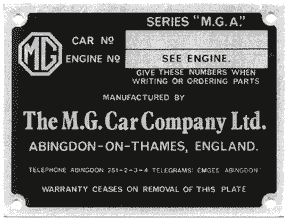
|
Addendum, 13 July 2007:
Here is an etched Car No. plate recently produced in very small quantity (30 piece initial batch). This is very impressive with the proper relieved black patina background and raised lettering. It is done in the 1600 model form with "SEE ENGINE" etched (actually engraved too deep) in the plate along with relieved background. On close inspection there are variations in the font and word positioning. The "M" in "M.G. Car Company" appears to have slanted sides, the line "Car No" is shorter than original, and other lines are of slightly different length than original. But it is (was) the only reproduction plate to date to have the proper relieved black background. Also available is engraving of the Car Number (so far not exactly the same as original stamping).
While quantity lasts you may procure one of these plates by contacting Serge Vliegen in Belgium. At last notice he had one left, but may do another production run if there was enough interest. For ordering information go to http://www.car-identification-plate.eu
Addendum, 22 September 2007:
Here is the second pass Car No. plate produced by Serge Vliegen. This one is even more impressive with the proper shallower relieved black patina background and raised lettering, and the correct font face and word positioning. The one shown here is in the 1500 model type with the blank space for stamping the engine number. Serge also has the 1600 model type plate with "SEE ENGINE" etched in black in the Engine Number space. He also has a similar plate for the MG TF and (maybe) also for the MG ZA/ZB Magnette. Also available is engraving of the Car Number and Engine Number (so far not exactly the same as original stamping).
While quantity lasts you may procure one of these plates by contacting Serge Vliegen in Belgium. For ordering information go to http://www.car-identification-plate.eu
Addendum October 2011:
This is a new addition to Serge Vliegen's original style MGA Car No. plate selection. It is for very early production MGA, possible the first 1000 cars. Difference here is one word in the lower left corner of the plate, "GUARANTEE" rather than "WARRANTY". See next page for more details.
Addendum June 2013:
Here's a nice chuckle for the originality enthusiasts.
R Mcknight in Haslemere, Surrey, UK wrote:
"Plate arrived safe and sound, it makes the Moss product look rubbish. We had builders in mixing up cement so I put it in the cement mixer for a couple of minutes with the mix and let it churn, then let it dry in the sun and then scoured the dried cement and it now looks 50 years old. Job done".
Addendum December 30, 2017:
On 12/29/2017, John Barrett of the mgatwincam group wrote:
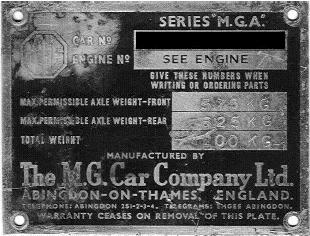 "If any group member owns a Deluxe which has the maximum permitted weight of the car on the chassis plate: If they could contact me I would be very grateful. They are most likely to be found on 'Deluxe' cars originally exported to Germany from the UK, often on cars with wheel nuts rather than spinners. Most of these cars, believed to be 26 of them, were then exported with US servicemen to America. If anybody knows any details of this arrangement that servicemen had, and how the cars were shipped (US Navy boats??) I would be interested to hear about that too".
"If any group member owns a Deluxe which has the maximum permitted weight of the car on the chassis plate: If they could contact me I would be very grateful. They are most likely to be found on 'Deluxe' cars originally exported to Germany from the UK, often on cars with wheel nuts rather than spinners. Most of these cars, believed to be 26 of them, were then exported with US servicemen to America. If anybody knows any details of this arrangement that servicemen had, and how the cars were shipped (US Navy boats??) I would be interested to hear about that too".
 -- John Barrett - email: carmadroy at yahoo.co.uk -- John Barrett - email: carmadroy at yahoo.co.uk
|
 "If any group member owns a Deluxe which has the maximum permitted weight of the car on the chassis plate: If they could contact me I would be very grateful. They are most likely to be found on 'Deluxe' cars originally exported to Germany from the UK, often on cars with wheel nuts rather than spinners. Most of these cars, believed to be 26 of them, were then exported with US servicemen to America. If anybody knows any details of this arrangement that servicemen had, and how the cars were shipped (US Navy boats??) I would be interested to hear about that too".
"If any group member owns a Deluxe which has the maximum permitted weight of the car on the chassis plate: If they could contact me I would be very grateful. They are most likely to be found on 'Deluxe' cars originally exported to Germany from the UK, often on cars with wheel nuts rather than spinners. Most of these cars, believed to be 26 of them, were then exported with US servicemen to America. If anybody knows any details of this arrangement that servicemen had, and how the cars were shipped (US Navy boats??) I would be interested to hear about that too". 



